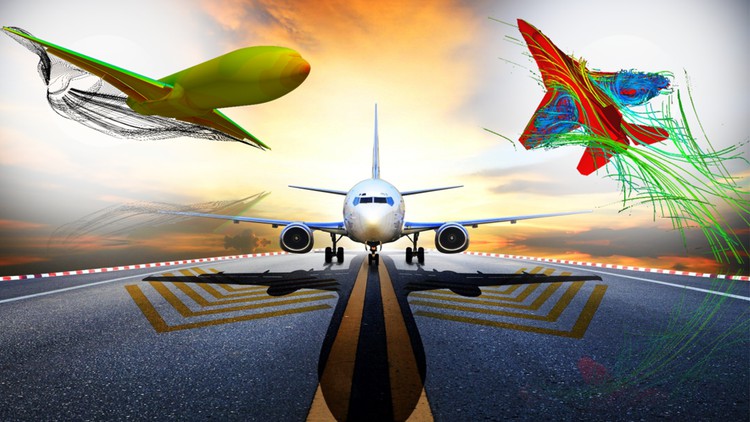Aircrafts classification
Basic fluid dynamics
Basics of aerodynamics
Air compressibility effects and supersonic speeds
Viscous flows including laminar and turbulent boundary layers
Mach numbers, pressure coefficients and shock waves development
Supercritical airfoil design
Transonic 3D wing design
Lift and Drag estimation techniques
Aerodynamics software
Advanced aerodynamics
This transonic aerodynamics course focuses on the study of the flow of air about an aircraft, but many of the concepts explored are relevant to a wide variety of applications from regular cars to Formula 1 bolides. Students completing this aerodynamics course will gain advanced understanding of concepts and techniques used to aerodynamically analyze and design transonic aircraft.
All transport aircrafts today are flying in with transonic speeds, so here you will learn everything you need to know for designing commercial aircraft such as Boeing or Airbus. The course will end by practical exercise where you will apply everything you have learned to design your own airfoil using a on open source software.
Get Instant Notification of New Courses on our
Telegram channel.
Note➛ Make sure your 𝐔𝐝𝐞𝐦𝐲 cart has only this course you're going to enroll it now, Remove all other courses from the 𝐔𝐝𝐞𝐦𝐲 cart before Enrolling!
What you will learn?:
- Aircrafts classification
- Basic fluid dynamics
- Basics of aerodynamics
- Air compressibility effects and supersonic speeds
- Viscous flows including laminar and turbulent boundary layers
- Mach numbers, pressure coefficients and shock waves development
- Supercritical airfoil design
- Transonic 3D wing design
- Lift and Drag estimation techniques
- Aerodynamics software
Introduction
Introduction
Why Learning Aerodynamics?
What Aerodynamics Is All About?
Aircraft Types and Purpose
Flying Principles and Aerostatics Principle
Aerodynamic and Inertial Flying Principles
Aircraft Components and Usage
Aerodynamic Schemes
Aircrafts Types and Perouse Quiz
Basic Aerodynamics
Coordinate Systems
Forces and Moments
General Atmosphere Information
Viscosity and Viscous Flows
Air Compressibility
Branches in Aerodynamics
Transonic Flow Fundamentals
What is Transonic Flow?
Physical Properties of Transonic Fluids
Advanced Compressibility
Pressure Coefficient
Mach Waves and Shock Waves
Transonic Airfoil
2D Airfoils
Compressibility Effects for Airfoils
Shock Waves on Airfoils
Viscous Flows
Boundary Layers on Airfoils
Viscous Flow Effects on Airfoils
Shock-Induced Separation for Airfoils
Real 3D Swept Wings
Classification of the Aircrafts
Definition of Swept Wing
General Design Considerations
Application of Wing Sweep
Swept Wing Design: Part 1
Swept Wing Design: Part 2
Swept Wing Performance
Military Swept Wing Design
Transonic Airfoil Performance
Airfoil Performance Background
Transonic Airfoil Characteristics
Compressibility and Wave Drag
General Drag Definition and Prediction
The Supercritical Airfoil
Drag Prediction | Near – Field Method
Drag Prediction | Far – Field Method
Example of Drag Calculation
Example of Calculation of Shock Induced Separation
Types of Shock Induced Separation
Swept Wing Performance
Boundary Layer Performance Method
Lift Dependent and Skin Friction Drag Method
Swept Wing Flow Separation
Software Tools For Aerodynamics
Aerodynamics Software: XFoil
Conclusions
How To Use What You’ve Learned?
What Comes Next In Aerospace Engineering?
Bonus Lecture: Discount Coupons
